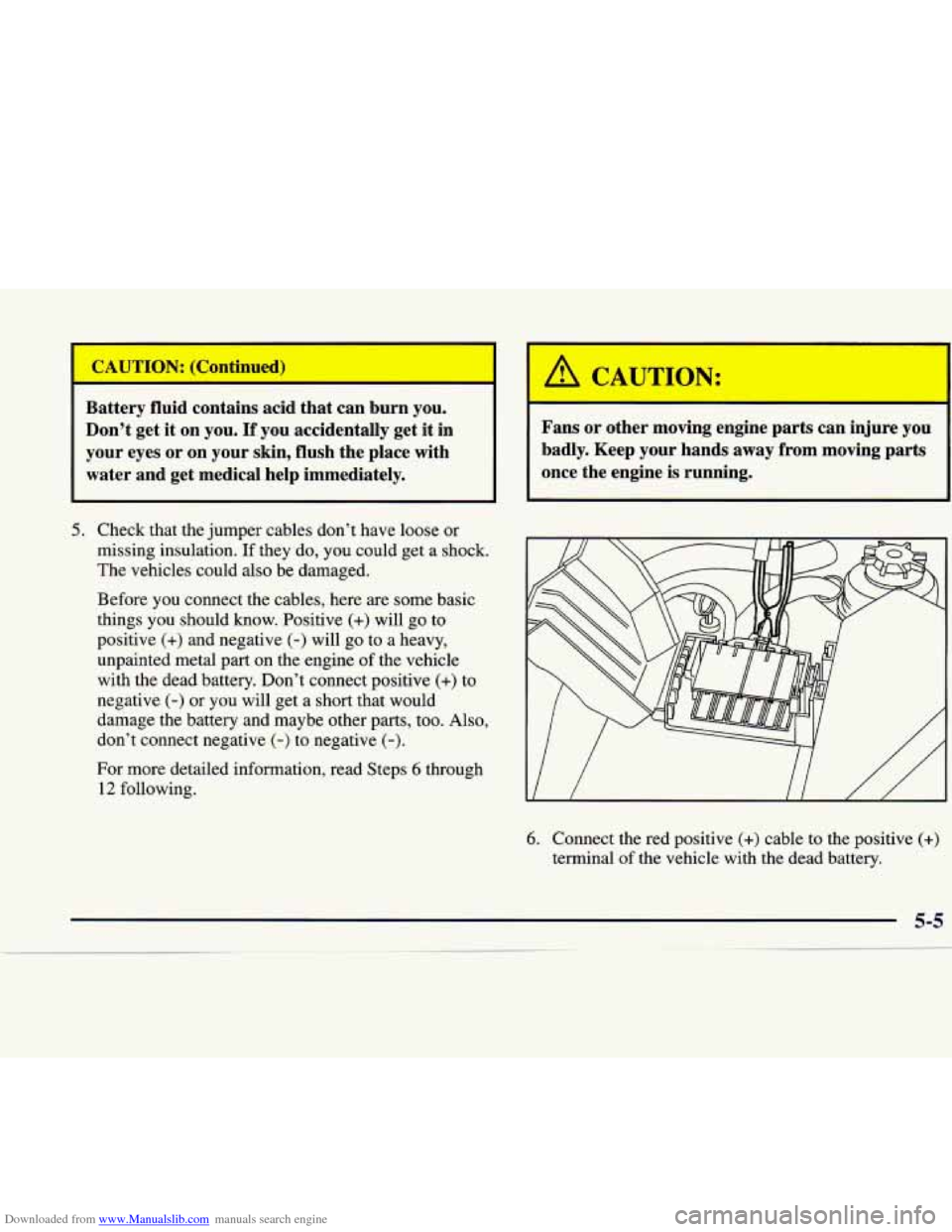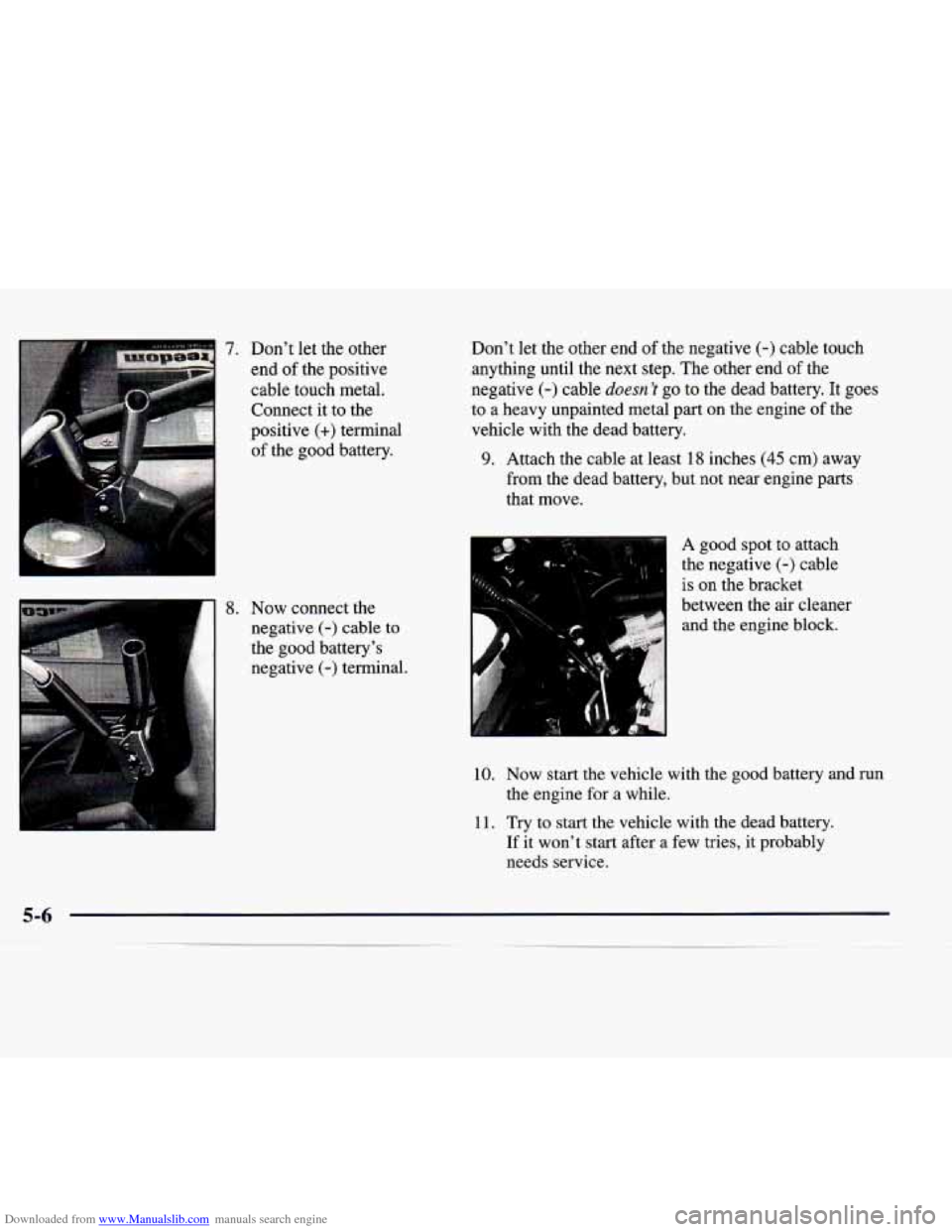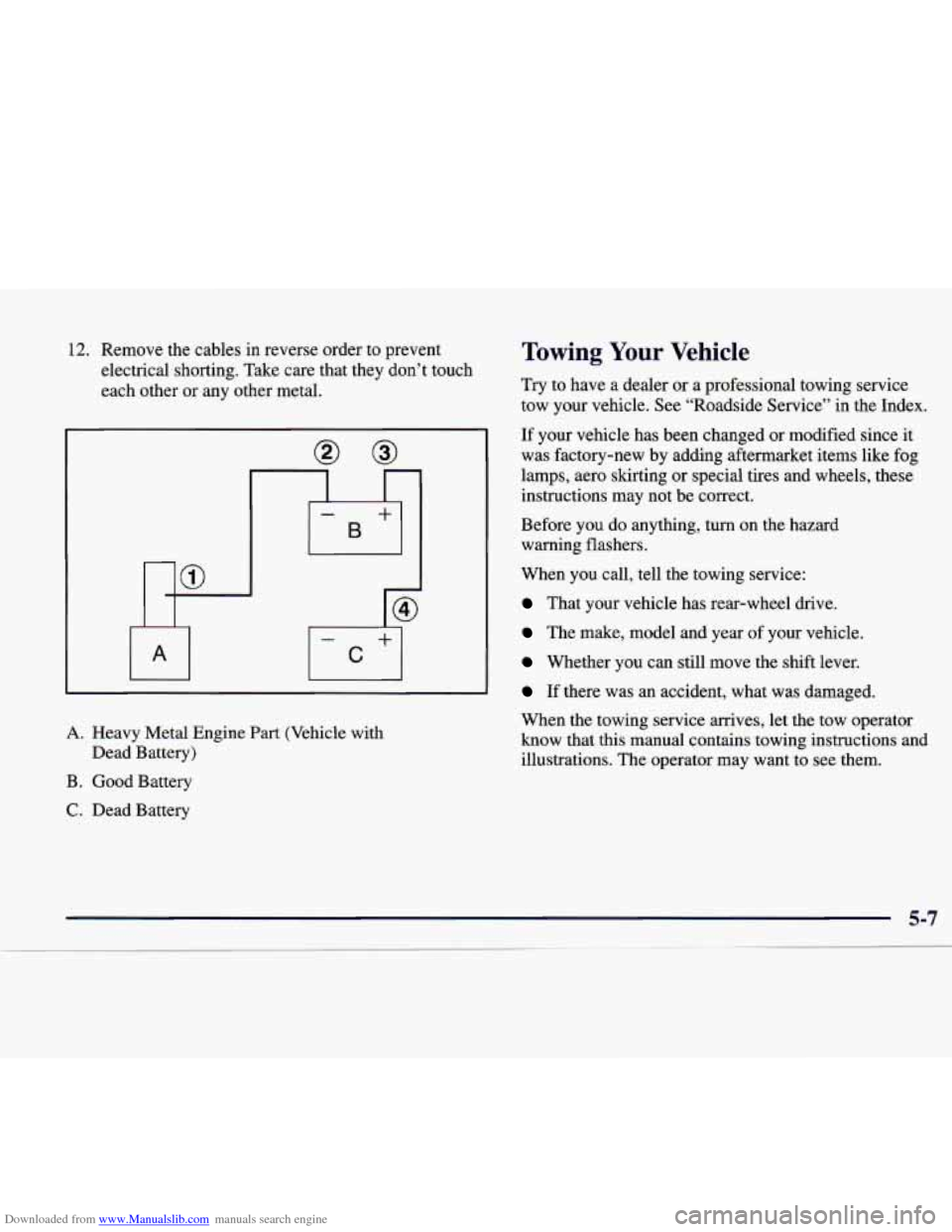1998 CADILLAC CATERA dead battery
[x] Cancel search: dead batteryPage 128 of 346

Downloaded from www.Manualslib.com manuals search engine 4. Using both hands, press the hand-held transmitter
button and the desired button on the universal
transmitter. Continue to hold both buttons
through Step
5.
light on the universal transmitter flash slowly and
then rapidly. The rapid flashing, which could take up
to
90 seconds, indicates that the universal transmitter
has been programmed. Release both buttons once the
light starts to flash rapidly.
5. Hold down both buttons until you see the indicator
If you have trouble programming the universal
transmitter, make sure that you have followed the
directions exactly as described and that the battery in the
hand-held transmitter is not dead. If you still cannot
program it, rotate the hand-held transmitter end over end
and
try again. The universal transmitter may not work
with older garage door openers that do not meet current
Federal Consumer Safety Standards.
If you cannot
program the transmitter after repeated attempts, consult
the manufacturer of the unit at 1-800-335-3515. Be sure
to keep the original hand-held transmitter
in case
you need to erase and reprogram the universal transmitter.
Note to Canadian Owners: During programming, the
hand-held transmitter may stop transmitting after one or
two seconds. If you are programming from one of these
transmitters,
you should press and re-press the button on
the hand-held transmitter every
two seconds without ever
releasing the button on the universal transmitter.
You may
have to repeat
this step several times while programming.
Page 220 of 346

Downloaded from www.Manualslib.com manuals search engine t
I A CAUTION:
I
Battery fluid contains acid that can burn you.
Don’t get it on you.
If you accidentally get it in Fans or other moving engine parts can injure you
your eyes or on your skin, flush the place with badly. Keep your hands
away from moving parts
water and get medical help immediately. once the engine
is running. -1
5. Check that the jumper cables don’t have loose or
missing insulation. If they do, you could get a shock.
The vehicles could also be damaged.
Before you connect the cables, here are some basic
things you should know. Positive
(+) will go to
positive
(+) and negative (-) will go to a heavy,
unpainted metal part on the engine
of the vehicle
with the dead battery. Don’t connect positive
(+) to
negative
(-) or you will get a short that would
damage the battery and maybe other parts,
too. Also,
don’t connect negative
(-> to negative (-).
For more detailed information, read Steps 6 through
12 following.
6. Connect the red positive (+) cable to the positive (+)
terminal of the vehicle with the dead battery.
Page 221 of 346

Downloaded from www.Manualslib.com manuals search engine 8. Now connect the
negative
(-) cable to
the good battery’s
negative
(-) terminal. Don’t let the other end
of the negative (-) cable touch
anything until the next step. The other end
of the
negative (-) cable doesn ’t go to the dead battery. It goes
to a heavy unpainted metal
part on the engine of the
vehicle with the dead battery.
9. Attach the cable at least 18 inches (45 cm) away
from the dead battery, but not near engine
parts
that move.
A good spot to attach
the negative
(-) cable
is on the bracket
between the air cleaner and the engine block.
10. Now start the vehicle with the good battery and run
the engine for a while.
11. Try to start the vehicle with the dead battery.
If it won’t start after a few tries,
it probably
needs service.
Page 222 of 346

Downloaded from www.Manualslib.com manuals search engine 12. Remove the cables in reverse order to prevent
electrical shorting. Take care that they don’t touch
each other or any other metal.
A. Heavy Metal Engine Part (Vehicle with
Dead Battery)
B. Good Battery
C. Dead Battery
Towing Your Vehicle
Try to have a dealer or a professional towing service
tow your vehicle. See “Roadside Service” in the Index.
If your vehicle has been changed
or modified since it
was factory-new by adding aftermarket items like fog
lamps, aero skirting or special tires and wheels, these
instructions may not be correct.
Before you do anything, turn on the hazard
warning flashers.
When you call, tell the towing service:
That your vehicle has rear-wheel drive.
The make, model and year of your vehicle.
Whether you can still move the shift lever.
If there was an accident, what was damaged.
When the towing service arrives, let the tow operator
know that this manual contains towing instructions and
illustrations. The operator may want to see them.
Page 332 of 346

Downloaded from www.Manualslib.com manuals search engine Cleaning Aluminum or Chrome Wheels
................... 6-50
Exterior LampsLenses
........................ 6-49
Fabric
................................. 6.46. 6.47
Glass Surfaces
............................... 6-48
Inside of Your Vehicle
......................... 6-46
Interior Plastic Components
..................... 6-48
Leather
..................................... 6-47
Outside of Your Vehicle
........................ 6-49
Speakercovers
.............................. 6-48
Special Problems
............................. 6-47
Tires
....................................... 6-51
Top of the Instrument Panel
..................... 6-48
Vinyl
....................................... 6-47
Wheels
..................................... 6-50
Climate Control System
........................... 3-2
Clock. Setting the
................................ 3-9
Comfort Controls
................................ 3-2
Compact Disc Changer Errors
..................... 3-25
Console Shift Lever
............................. 2-25
ConsoleStorage
................................ 2-48
Control
of a Vehicle .............................. 4-6
ConvenienceNet
............................... 2-49
Convex Outside Mirror
.......................... 2-47
Coolant
....................................... 6-20
Adding
..................................... 6-23
Heater. Engine
............................... 2- 19
Outside
of the Windshield and Wiper Blades
....... 6-49
Checking
................................... 6-22 SurgeTank
................................... .. 5-14
WhattoUse
................................. 6-21
Cooling System
................................ 5-14
Cornering Lamps
............................... 2-43
Cruise Control
................................. 2-36
Cruise Control Light
............................ 2-74
Customer Assistance for Text Telephone (TTY) Users
.................................. 7-4
Customer Assistance Information
................... 7-1
Customer Satisfaction Procedure .................... 7-2
Damage. Finish
............................... 6-51
Damage. Sheet Metal
............................ 6-51
Daytime Running Lamps
......................... 2-41
DeadBattery
................................... 5-3
Defects. Reporting Safety
................... 7- 12. 7- 13
Defensive Driving
............................... 4-2
Defogger. Rear Window
.......................... 3-8
Defrosting
..................................... 3-8
Dimensions. Vehicle
............................ 6-64
Dolby B Noise Reduction
................... 3.12. 3.19
Door Central Unlocking System
....................... 2-5
Locks
....................................... 2-4
Drive Position. Automatic Transmission
............. 2-22
Driver Position
................................. 1-19
Driver’s Side Instrument Panel Fuse Block
........... 6-57
Driver’s Side Temperature Knob
.................... 3-2